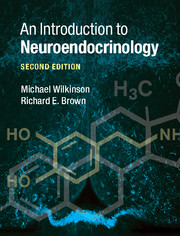Book contents
- Frontmatter
- Dedication
- Contents
- Preface to the second edition
- Acknowledgements
- List of abbreviations
- 1 Classification of chemical messengers
- 2 The endocrine glands and their hormones
- 3 The pituitary gland and its hormones
- 4 The hypothalamic hormones
- 5 Neurotransmitters
- 6 Neurotransmitter and neuropeptide control of hypothalamic, pituitary and other hormones
- 7 Regulation of hormone synthesis, storage, release, transport and deactivation
- 8 Regulation of hormone levels in the bloodstream
- 9 Steroid and thyroid hormone receptors
- 10 Receptors for peptide hormones, neuropeptides and neurotransmitters
- 11 Neuropeptides I: classification, synthesis and co-localization with classical neurotransmitters
- 12 Neuropeptides II: function
- 13 Cytokines and the interaction between the neuroendocrine and immune systems
- 14 Methods for the study of behavioral neuroendocrinology
- 15 An overview of behavioral neuroendocrinology: present, past and future
- Index
- References
1 - Classification of chemical messengers
Published online by Cambridge University Press: 05 June 2015
- Frontmatter
- Dedication
- Contents
- Preface to the second edition
- Acknowledgements
- List of abbreviations
- 1 Classification of chemical messengers
- 2 The endocrine glands and their hormones
- 3 The pituitary gland and its hormones
- 4 The hypothalamic hormones
- 5 Neurotransmitters
- 6 Neurotransmitter and neuropeptide control of hypothalamic, pituitary and other hormones
- 7 Regulation of hormone synthesis, storage, release, transport and deactivation
- 8 Regulation of hormone levels in the bloodstream
- 9 Steroid and thyroid hormone receptors
- 10 Receptors for peptide hormones, neuropeptides and neurotransmitters
- 11 Neuropeptides I: classification, synthesis and co-localization with classical neurotransmitters
- 12 Neuropeptides II: function
- 13 Cytokines and the interaction between the neuroendocrine and immune systems
- 14 Methods for the study of behavioral neuroendocrinology
- 15 An overview of behavioral neuroendocrinology: present, past and future
- Index
- References
Summary
Hormones, the brain and behavior
Neuroendocrinology is the study of how the brain controls the endocrine systems that keep us alive and able to reproduce. However, an essential and critical characteristic of this neural control of the endocrine systems is that endocrine hormones in turn have profound effects on brain function through feedback systems. Research on hormones and the brain is intensive and covers many fields: from cell and molecular biology and genetics to anatomy, physiology, pharmacology, biochemistry, medicine, psychiatry and psychology. This book will examine the interactions between hormones, the brain and behavior. Thus, the primary focus will be on how the endocrine and nervous systems affect each other to produce an integrated functional neuroendocrine system that influences physiological and behavioral responses. As preliminary background reading, students are referred to any modern text on Human Physiology (see “Further reading” at the end of this chapter).
When you hear the term “hormone,” for example steroid hormone, you think of the endocrine glands and how their secretions influence physiological responses in the body, but this is only part of the picture. Many of the endocrine glands (although not all of them) are influenced by the pituitary gland, the so-called “master gland,” and the pituitary is itself controlled by various hormones secreted from the hypothalamus, a part of the brain situated directly above the pituitary gland. The release of hypothalamic hormones is in turn regulated by neurotransmitters released from nerve cells (neurons) in the brain. Some neurotransmitters released within the brain also control behavior, and the secretion of neurotransmitters from specific nerve cells can be modulated by the level of specific endocrine hormones in the circulation. This is called hormone feedback. Thus, neurotransmitter release influences both hormones and behavior and, in turn, hormones regulate the release of neurotransmitters. This interaction between hormones, the brain and behavior involves a wide variety of chemical messengers which are described in this chapter.
- Type
- Chapter
- Information
- An Introduction to Neuroendocrinology , pp. 1 - 18Publisher: Cambridge University PressPrint publication year: 2015



